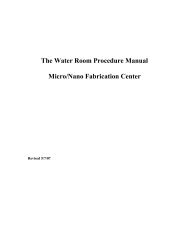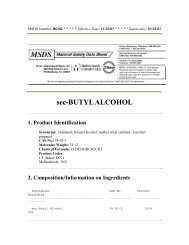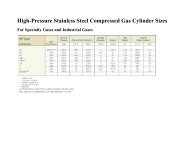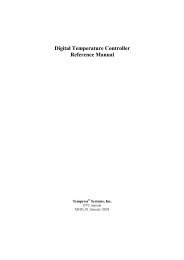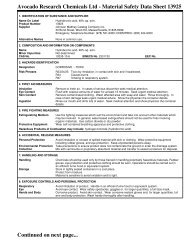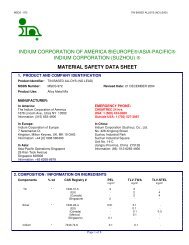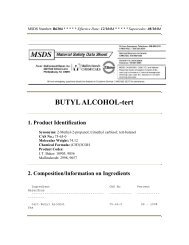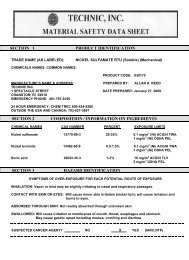Shipley 1818 Photoresist
Shipley 1818 Photoresist
Shipley 1818 Photoresist
You also want an ePaper? Increase the reach of your titles
YUMPU automatically turns print PDFs into web optimized ePapers that Google loves.
1. PRODUCT AND COMPANY IDENTIFICATION<br />
MICROPOSIT S<strong>1818</strong> Positive <strong>Photoresist</strong><br />
Revision date: 04/02/2004<br />
Supplier Rohm and Haas Electronic Materials LLC<br />
455 Forest Street<br />
Marlborough, MA 01752 United States of America<br />
For non-emergency information contact: 508-481-7950<br />
Emergency telephone number<br />
Chemtrec 800-424-9300<br />
Rohm and Haas Emergency 215-592-3000<br />
2. COMPOSITION/INFORMATION ON INGREDIENTS<br />
Component CAS-No. Concentration<br />
Electronic grade propylene glycol monomethyl<br />
ether acetate<br />
108-65-6 65.0 - 95.0 %<br />
Mixed cresol novolak resin < 30.0 %<br />
Cresol 1319-77-3 < 0.9 %<br />
Diazo Photoactive Compound 1.0 - 10.0 %<br />
Fluoroaliphatic Polymer Esters 11114-17-3 < 1.0 %<br />
3. HAZARDS IDENTIFICATION<br />
Emergency Overview<br />
Appearance<br />
Form liquid<br />
Colour Red Amber<br />
Odour ester-like<br />
Hazard Summary CAUTION!<br />
Combustible liquid and vapor. Causes irritation to eyes, nose, and<br />
respiratory tract.<br />
Prolonged, repeated contact, inhalation, ingestion, or absorption<br />
through the skin, may cause toxic effects to internal organ systems<br />
(liver, kidney, central nervous system).<br />
Potential Health Effects<br />
Material Safety Data Sheet<br />
Page 1 of 8 Revision date 04/02/2004
MICROPOSIT(TM) S<strong>1818</strong>(TM) Positive <strong>Photoresist</strong><br />
Primary Routes of Entry: Inhalation, ingestion, eye and skin contact, absorption.<br />
Eyes: May cause pain, transient irritation and superficial corneal effects.<br />
Skin: Material may cause irritation.<br />
Prolonged or repeated exposure may have the following effects:<br />
drowsiness<br />
defatting and drying of the skin which can lead to irritation and dermatitis<br />
central nervous system depression<br />
kidney damage<br />
liver damage<br />
Ingestion: Swallowing may have the following effects:<br />
irritation of mouth, throat and digestive tract<br />
headache<br />
nausea<br />
vomiting<br />
Repeated doses may have the following effects:<br />
central nervous system depression<br />
liver damage<br />
kidney damage<br />
Inhalation: Inhalation may have the following effects:<br />
irritation of nose, throat and respiratory tract<br />
Higher concentrations may have the following effects:<br />
systemic effects similar to those resulting from ingestion<br />
Target Organs: Eye<br />
Respiratory System<br />
nervous system<br />
Liver<br />
Kidney<br />
Skin<br />
Carcinogenicity<br />
Not considered carcinogenic by NTP, IARC, and OSHA<br />
4. FIRST AID MEASURES<br />
Inhalation: Remove from exposure. If there is difficulty in breathing, give oxygen. Seek medical<br />
attention if symptoms persist.<br />
Skin contact: Wash skin with water. Continue washing for at least 15 minutes. Obtain medical<br />
attention if blistering occurs or redness persists.<br />
Eye contact: Immediately flush the eye with plenty of water for at least 15 minutes, holding the eye<br />
open. Obtain medical attention if soreness or redness persists.<br />
Ingestion: Wash out mouth with water. Have victim drink 1-3 glasses of water to dilute stomach<br />
contents. Induce vomiting if person is conscious. Immediate medical attention is required Never<br />
administer anything by mouth if a victim is losing conciousness, is unconcious or is convulsing.<br />
Notes to physician<br />
Page 2 of 8 Revision date 04/02/2004
Treat symptomatically.<br />
5. FIRE-FIGHTING MEASURES<br />
Flash point 40 - 46 °C (104 - 115 °F )<br />
Suitable extinguishing<br />
media:<br />
MICROPOSIT(TM) S<strong>1818</strong>(TM) Positive <strong>Photoresist</strong><br />
Use water spray, foam, dry chemical or carbon dioxide.<br />
Keep containers and surroundings cool with water spray.<br />
Specific hazards during fire fighting: This product may give rise to hazardous vapors in a fire.<br />
Vapors can travel a considerable distance to a source of ignition and result in flashback.<br />
Special protective equipment for fire-fighters: Wear full protective clothing and self-contained<br />
breathing apparatus.<br />
Further information: Pressure may build up in closed containers with possible liberation of<br />
combustible vapors.<br />
6. ACCIDENTAL RELEASE MEASURES<br />
Personal precautions<br />
Wear suitable protective clothing.<br />
Wear respiratory protection.<br />
Eliminate all ignition sources.<br />
Environmental precautions<br />
Prevent the material from entering drains or water courses.<br />
Do not discharge directly to a water source.<br />
Advise Authorities if spillage has entered watercourse or sewer or has contaminated soil or vegetation.<br />
Methods for cleaning up<br />
Contain spills immediately with inert materials (e.g., sand, earth).<br />
Transfer into suitable containers for recovery or disposal.<br />
Finally flush area with plenty of water.<br />
7. HANDLING AND STORAGE<br />
Handling<br />
Use local exhaust ventilation. Avoid contact with eyes, skin and clothing. Keep container tightly<br />
closed.<br />
Further information on storage conditions: Proprietary photoresist film contains approximately 2-<br />
4% of 2,3,4-trihydroxybenzophenone(THBP), which may sublime during soft-bake or hard-bake<br />
processing. THBP has low acute toxicity (LD50>5g/kg). Contact with eyes, skin or mucous<br />
membranes cause irritation. To prevent accumulation of THBP on equipment surfaces and ventilation<br />
ducts, preventative maintenance program including regular cleaning should be implemented. Wipe<br />
surfaces using an appropriate cleaning solvent when possible. Provide adequate general or local<br />
exhaust ventilation during the cleaning process. In situations where this is not possible or where<br />
solvent or dust concentrations become excessive, use an air purifying respirator with an organic vapor/<br />
toxic particulate cartridge. When cleaning residual THBP, wear protective gloves and adequate<br />
protective clothing to prevent skin contact. Practice good personal hygiene to prevent accidental<br />
exposure. Clean all protective clothing and equipment thoroughly after each use.<br />
Page 3 of 8 Revision date 04/02/2004
MICROPOSIT(TM) S<strong>1818</strong>(TM) Positive <strong>Photoresist</strong><br />
Storage<br />
Storage conditions: Store in original container. Keep away from heat and sources of ignition.<br />
Storage area should be: cool dry well ventilated out of direct sunlight<br />
8. EXPOSURE CONTROLS / PERSONAL PROTECTION<br />
Exposure limit(s)<br />
Exposure limits are listed below, if they exist.<br />
Component Regulation Type of listing Value<br />
Electronic grade propylene<br />
glycol monomethyl ether<br />
acetate<br />
Rohm and Haas TWA 30 ppm<br />
Rohm and Haas STEL 90 ppm<br />
Rohm and Haas Absorbed via skin<br />
Component Regulation Type of listing Value<br />
Cresol ACGIH TWA 22 mg/m3 5 ppm<br />
ACGIH SKIN_DES<br />
OSHA_TRANS PEL 22 mg/m3 5 ppm<br />
OSHA_TRANS SKIN_DES<br />
Eye protection: goggles<br />
Hand protection: Butyl rubber gloves. Other chemical resistant gloves may be recommended by your<br />
safety professional.<br />
Skin and body protection: Normal work wear.<br />
Respiratory protection: Respiratory protection if there is a risk of exposure to high vapor<br />
concentrations. The specific respirator selected must be based on the airborne concentration found in<br />
the workplace and must not exceed the working limits of the respirator.<br />
Engineering measures: Engineering methods to prevent or control exposure are preferred.<br />
Methods include process or personnel enclosure, mechanical ventilation (local exhaust), and control of<br />
process conditions.<br />
9. PHYSICAL AND CHEMICAL PROPERTIES<br />
Appearance<br />
Form liquid<br />
Colour Red Amber<br />
Odour ester-like<br />
pH neutral<br />
Boiling point/range ca.146 °C (295 °F)<br />
Flash point 40 - 46 °C (104 - 115 °F)<br />
Page 4 of 8 Revision date 04/02/2004
MICROPOSIT(TM) S<strong>1818</strong>(TM) Positive <strong>Photoresist</strong><br />
Component: Electronic grade propylene glycol monomethyl ether acetate<br />
Vapour pressure 3.7 mmHg at 20 °C<br />
Relative vapour density Heavier than air.<br />
Water solubility insoluble<br />
Relative density 0.80 - 1.00<br />
Evaporation rate Slower than ether<br />
VOC's 727 - 950 g/l<br />
NOTE: The physical data presented above are typical values and should not be construed as a<br />
specification.<br />
10. STABILITY AND REACTIVITY<br />
Hazardous reactions Stable under normal conditions.<br />
Conditions to avoid High temperatures Static discharge<br />
Materials to avoid Oxidizing agents<br />
Hazardous<br />
decomposition<br />
products<br />
polymerization Will not occur.<br />
11. TOXICOLOGICAL INFORMATION<br />
Combustion will generate:, Carbon monoxide, carbon dioxide, phenols,<br />
nitrogen oxides (NOx), aldehydes, acrid smoke and irritating fumes,<br />
Toxicological information on this product or its components appear in this section when such data is<br />
available.<br />
Component: Electronic grade propylene glycol monomethyl ether acetate<br />
Acute oral toxicity LD50 rat 8,532 mg/kg<br />
Component: Cresol<br />
Acute oral toxicity LD50 rat 2,737 mg/kg<br />
Component: Fluoroaliphatic Polymer Esters<br />
Acute oral toxicity LD50 rat > 10,000 mg/kg<br />
Component: Electronic grade propylene glycol monomethyl ether acetate<br />
Acute inhalation LC50 rat 6 h 23.49 mg/l<br />
toxicity<br />
Component: Cresol<br />
Acute inhalation LC50 rat 8 h 35.38 mg/l<br />
toxicity<br />
Component: Electronic grade propylene glycol monomethyl ether acetate<br />
Acute dermal toxicity LD50 rabbit >5,000 mg/kg<br />
Component: Cresol<br />
Page 5 of 8 Revision date 04/02/2004
Acute dermal toxicity LD50 rabbit > 5,000 mg/kg<br />
Component: Fluoroaliphatic Polymer Esters<br />
Acute dermal toxicity > 5,000 mg/kg<br />
MICROPOSIT(TM) S<strong>1818</strong>(TM) Positive <strong>Photoresist</strong><br />
Component: Electronic grade propylene glycol monomethyl ether acetate<br />
Toxicity to reproduction<br />
Dermal teratology testing of this solvent (with less than 3% beta isomer) revealed no maternally<br />
toxic, teratogenic or fetotoxic responses in rats or rabbits exposed to concentrations of 1,000 and<br />
2,000 mg/kg per day.<br />
Component: Electronic grade propylene glycol monomethyl ether acetate<br />
Mutagenicity<br />
No significant mutagenic response was observed and the carcinogenic potential of the material is<br />
therefore considered to be low.<br />
Component: Cresol<br />
Toxicity to reproduction<br />
Developmental effects were seen in laboratory animals only at dose levels that were maternally<br />
toxic.<br />
12. ECOLOGICAL INFORMATION<br />
Ecotoxicological information on this product or its components appear in this section when such data<br />
is available.<br />
Electronic grade propylene glycol monomethyl ether acetate<br />
Ecotoxicity effects<br />
Toxicity to fish LC50 Fathead minnow (Pimephales promelas) 96 h<br />
161 mg/l<br />
Toxicity to aquatic<br />
invertebrates<br />
13. DISPOSAL CONSIDERATIONS<br />
EC50 Daphnia magna 48 h<br />
>500 mg/l<br />
Environmental precautions: Prevent the material from entering drains or water courses.<br />
Do not discharge directly to a water source.<br />
Advise Authorities if spillage has entered watercourse or sewer or has contaminated soil or vegetation.<br />
Disposal<br />
Dispose in accordance with all local, state (provincial), and federal regulations. Incineration is the<br />
recommended method of disposal for containers. Under RCRA, it is the responsibility of the product's<br />
user to determine at the time of disposal, whether the product meets RCRA criteria for hazardous<br />
waste. This is because the product uses, transformations, mixtures, processes, etc. may render the<br />
resulting materials hazardous.<br />
Do not remove label until container is thoroughly cleaned. Empty containers may contain hazardous<br />
residues. This material and its container must be disposed of in a safe way.<br />
14. TRANSPORT INFORMATION<br />
DOT<br />
Page 6 of 8 Revision date 04/02/2004
IMO/IMDG<br />
MICROPOSIT(TM) S<strong>1818</strong>(TM) Positive <strong>Photoresist</strong><br />
Not regulated per 49CFR 173.150(f)(2)<br />
Proper shipping name RESIN SOLUTION<br />
UN-No UN 1866<br />
Class 3<br />
Packing group<br />
III<br />
15. REGULATORY INFORMATION<br />
SARA TITLE III: Section 311/312 Categorizations (40CFR370): Immediate, delayed,<br />
flammability hazard<br />
SARA TITLE III: Section 313 Information (40CFR372)<br />
This product does not contain a chemical which is listed in Section 313 at or above de minimis<br />
concentrations.<br />
U.S. Toxic Substances Control Act (TSCA) Section 12(b) Export Notification (40 CFR<br />
707, Subpt D):<br />
U.S. Toxic Substances Control Act (TSCA) Section 12(b) Export Notification (40 CFR 707, Subpt D)<br />
This product does not contain any substances subject to Section 12(b) export notification.<br />
US. Toxic Substances Control Act (TSCA) All components of this product are in compliance<br />
with the inventory listing requirements of the U.S. Toxic Substances Control Act (TSCA) Chemical<br />
Substance Inventory.<br />
California (Proposition 65)<br />
This product does not contain materials which the State of California has found to cause cancer, birth<br />
defects or other reproductive harm.<br />
16. OTHER INFORMATION<br />
Hazard Rating<br />
Health Fire Reactivity<br />
NFPA 2 2 0<br />
Legend<br />
ACGIH American Conference of Governmental Industrial Hygienists<br />
BAc Butyl acetate<br />
OSHA Occupational Safety and Health Administration<br />
PEL Permissible Exposure Limit<br />
STEL Short Term Exposure Limit (STEL):<br />
TLV Threshold Limit Value<br />
TWA Time Weighted Average (TWA):<br />
| Bar denotes a revision from prior MSDS.<br />
Page 7 of 8 Revision date 04/02/2004
MICROPOSIT(TM) S<strong>1818</strong>(TM) Positive <strong>Photoresist</strong><br />
The information provided in this Safety Data Sheet is correct to the best of our knowledge, information<br />
and belief at the date of its publication. The information given is designed only as a guidance for safe<br />
handling, use, processing, storage, transportation, disposal and release and is not to be considered a<br />
warranty or quality specification. The information relates only to the specific material designated and<br />
may not be valid for such material used in combination with any other materials or in any process,<br />
unless specified in the text.<br />
Version: 3.0<br />
Print Date: 11/30/2005<br />
Layout 305833<br />
Page 8 of 8 Revision date 04/02/2004



